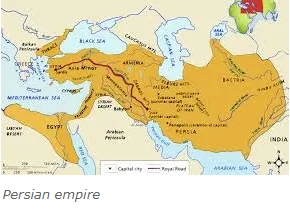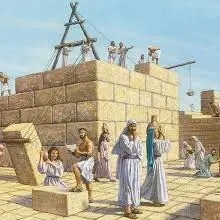Source For This Article
FROM DANIEL TO REVELATION
2018-04-07 BY ANDRIES VAN NIEKERK
With what decree did the 490 years of Daniel 9 begin?
ABSTRACT: The 490 years begin with a decree to restore and rebuild Jerusalem (Dan 9:25). To restore a city means to return all rights to the previous owner. To restore a capital city, such as Jerusalem, means to give the nation the right to rule itself from that city. This article evaluates five possible decrees in terms of whether they:
- Restored the city,
- Allowed the city to be rebuilt, and whether they
- Fit the time of Christ.
PURPOSE
The 70 weeks (490 years) of Daniel 9 begin with a decree:
"FROM the issuing of a decree to restore and rebuild Jerusalem" (Dan 9:25)
Identification of this decree is very important for a correct interpretation of the 490 years. A number of historical decrees with different dates have been suggested by scholars. For example, in Dispensationalism, the "decree to restore and rebuild Jerusalem" (Dan 9:25) was Artaxerxes' second decree in 445/4 BC (Neh 1-2). This article evaluates these decrees and identifies the decree that fits the prophecy best.
RESTORE AND REBUILD
The right decree will both "restore" and "rebuild" Jerusalem. "Restore" and "rebuild" are two related but very different actions:
Rebuild means to physically reconstruct.
Restore - The word translated as "restore" (shûb) does not mean the same as "rebuild." To restore a city means to return ownership to the previous owner, for example:
The Aramean king once said to Ahab, king of Israel: "I will return
(shûb, "restore") the cities my father took from your father"
(I Kings 20:34). These cities have not been destroyed and were
simply returned (given back) to Israel.
Azariah, king of Judah, rebuilt and restored the city Elath to Judah
(2 Kings 14:22). This verse contains both verbs in Daniel 9:25;
"rebuild" and "restore." The city had been in ruins. After it was rebuilt,
it was restored (returned or given back) to Judah to rule as their own
(cf. 1 Kings 12:21).
Restoring (shûb) Jerusalem in Daniel 9:25, therefore, does not include rebuilding. It also means more than merely allowing the Jews to live in the city. "Restore" means that Jerusalem would again be owned by the Israelites. And since Jerusalem was the judicial and executive capital of the nation, to restore the city means to return ownership to the Jews to serve as their capital from where they would govern themselves according to their own laws.

JEREMIAH'S PROPHECY
Critical scholars are academics who do not accept the divine inspiration of Daniel. They do not believe that Daniel 9 refers to Jesus, but rather propose that Daniel was written during the persecution of the Jews by the Greek king Antiochus IV (around 165 BC) and that that crisis is also the crisis in Daniel. In other words, they propose that Daniel is history written in the form of a prophecy.
Since such scholars have to fit 490 years between the decree and the time of Antiochus, they select the earliest possible decree. For this reason, they propose that the decree to restore and rebuild Jerusalem is a 'decree of God' via the prophet Jeremiah.
But even if they take the very first mention by Jeremiah of the coming destruction and restoration of Jerusalem, in about 605 BC, they still only have 440 years until the time of Antiochus; not the required 490 (70×7) years. They usually explain the difference as a mistake made by the uninspired writer of the book of Daniel. But people who accept Daniel as supernaturally inspired, and particularly people who accept the messiah in Daniel 9 as referring to Jesus Christ, do not accept the announcements by Jeremiah as the decree to restore and rebuild Jerusalem.
FOUR PERSIAN DECREES
The books by Ezra and Nehemiah mention four different
"decrees" that deal with the return of the exiles and the
rebuilding of the temple and city. These decrees were
issued by three different Persian monarchs over a period
of 93 years:
1. 538/7 BC: Cyrus allowed Jews to return to Judah and to
rebuild the temple (Ezra 1:1-4; cf. Isa 45:1).
2. About 520 BC: Darius I reaffirmed and expedited the
order of Cyrus (Ezra 6:1-12).
3. 457 BC: Artaxerxes I granted a decree to Ezra
(Ezra 7:12-26) to re-establish the autonomy of Judah.
4. 445/444 BC: Artaxerxes I gave permission to Nehemiah
to repair Jerusalem.
One of these must be the decree to restore and rebuild Jerusalem.

CYRUS - 538/7
More than a century before Cyrus was born, God inspired Isaiah to write:
"Who says of Cyrus, 'He is my shepherd, and he shall fulfill all my
purpose'; saying of Jerusalem, 'She shall be rebuilt,' and of the
temple, 'Your foundation shall be laid'" (Isa 44:28).
"He (Cyrus) shall build my city and set my exiles free" (Isa 45:13).
In 538/7 BC, Cyrus decreed as follows:
"The Lord, the God of heaven … has appointed me to build a
temple for him at Jerusalem in Judah. Anyone of his people
among you … let him go up to Jerusalem in Judah and build
the temple of the Lord, the God of Israel" (Ezra 1:2-4).
The decree by Cyrus allowed the Jews to return to Judea and to rebuild the temple (Ezra 1:1-4; cf. Isa 45:1). It also implies the right to rebuild their cities, including Jerusalem. But that decree did not "restore" Jerusalem as required by Daniel 9:25, for it did not allow the Jews to rule themselves. It did not give Jerusalem back to the nation to serve as their national capital; to make their own laws, to govern themselves. They were still ruled directly by Persian laws.
Isaiah predicted that Cyrus "shall build my city and set my exiles free" (Isa 45:13), but Cyrus did not set the Israelites free to rule themselves; only to return to Judea. Nevertheless, Cyrus did initiate a process that ultimately led to the decree to restore Jerusalem to the Jews, to serve as their judicial capital.

DARIUS I - 520 BC
In response to Cyrus' edict, the Jews slowly began to return to their homeland (Ezra 3). More than 15 years later Haggai and Zechariah (their ministry began about 520 BC) tell us that instead of making the rebuilding of the temple their priority, the returnees had set about their own business. While the affluent built luxury homes, the majority of the returned exiles lived in and around the ruined city and suffered crop failures and droughts. The temple remained in ruins
(Haggai 1:1-11).
Zerubbabel and Joshua, under the influence of the prophets Haggai and Zechariah, again started to rebuild the temple seventeen years after the decree of Cyrus, but experienced resistance (Ezra 5). Israel's old enemies - the Samaritans - complained to the authorities. In response, the local governor inspected the work and wrote a letter to Darius to verify the rights of the Jews. An investigation was made and the decree of Cyrus was found. Darius confirmed the decree of Cyrus by means of an additional edict (ca. 520 BC) (Ezra 6:3-12). The temple was finished and dedicated in March, 515 BC
(Ezra 6:13-18).
The royal decree of Darius I mentions only the restoration of the temple. It simply confirmed Cyrus' edict, and therefore also did not restore Jerusalem as legislative and executive capital of the nation in order that the Jews may govern themselves.
[Note that the Samaritans appealed to the Persian authorities, which confirms that Jerusalem has not yet been "restored," as defined above.]
This leaves us to choose between the two decrees issued by
Artaxerxes I in 458/7 (Ezra 7:1-26) and in 445/4 BC (Neh 1-2) respectively:


ARTAXERXES - 458/7 BC
The decree in 458/7 BC (Ezra 7:12-26), about 60 years after the
temple had been completed, granted permission to the exiles to
return to Jerusalem, assigned funds for the support of the temple
in Jerusalem, and exempted the temple and temple personnel
from tax. These are not different from the previous decrees. But
what was now added is that the decree established a legal
system based on the Torah for all the Jews in Judea. This
included appointing magistrates and judges to enforce the law.
Judea was to enjoy significant judicial and civil autonomy under
the larger overlordship of Persia. Of particular importance is
Ezra 7:26:
"Whoever does not obey the law of your God and the law
of the king must surely be punished by death, banishment,
confiscation of property, or imprisonment."
In this way, the Persian king made the Mosaic law part of his
own law and granted authority to the Jews to govern themselves
on the basis of the law of God. It provided for a measure of
judicial autonomy unknown since the Babylonian desolation of
Jerusalem and Judea about 130 years earlier (Ezra 7:25-26).
In response to this decree, Ezra, with a considerable company
of people (priests, Levites, singers, gatekeepers, and temple servants), went up from Babylon in Mesopotamia to Jerusalem in the seventh year of his reign (Ezra 7:6-7, 11-17). After a journey lasting several months, they arrived at Jerusalem.
All historical sources point unanimously and harmoniously to the fact that
the seventh regnal year of Artaxerxes I extended from March/April of
458 BC to March/April of 457 BC. The Jews, however, did not use the
Persian-Babylonian March/April calendar. Their calendar began in
September/October:
Nehemiah 1:1 and 2:1 provide specific evidence for this. Both verses
date events to Artaxerxes' twentieth year, but to different months. In
Neh 1:1, it is the "month Chislev" and in Nehemiah 2:1, it is the "month
Nisan." But in the Persian-Babylonian calendar, Chislev was the ninth
month and Nisan was the first. If Nehemiah had used the Persian-
Babylonian calendar, then Nehemiah 2:1 should have been dated to
Artaxerxes' twenty-first regnal year. The fact that the regnal year number
did not change is evidence that Nehemiah used the Jewish calendar,
which used the same names for months but started the year in a
different month.
Since Ezra was a contemporary of Nehemiah, we may apply the same Jewish calendar to the dates in Ezra. This would mean that the decree recorded in Ezra 7 was issued sometime in the year that began in September/October of the year 458.



ARTAXERXES - 445/4
In the king's twentieth year (Neh 2:1) (445/4 BC) Nehemiah,
cupbearer to Artaxerxes I, received a report from a group of Jews
who had arrived in the Persian capital from Jerusalem:
"The survivors there in the province who escaped exile are in
great trouble and shame; the wall of Jerusalem is broken down,
and its gates are destroyed by fire" (Neh 1:3; cf. 2:3).
Nehemiah then requested and obtained permission from
Artaxerxes to return to Jerusalem to rebuild the city (Neh 2:5).
TWO DECREES OF ARTAXERXES
We have to choose between the two decrees of Artaxerxes. For the following reasons, it is proposed that the 458/7-decree is the decree to restore and rebuild Jerusalem:
(1) It fits the time of Christ and
(2) It "restored" Jerusalem to the Jews.
THE TIME OF CHRIST.
Daniel 9:25 continues:
"from the issuing of a decree … until Messiah the Prince there will be seven weeks and sixty-two weeks."
In other words, the Messiah would appear (7+62)x7 = 483 years after the decree.
DISPENSATIONAL VIEW
In Dispensationalism, this Messiah Prince is Jesus Christ and 483 years after the decree brings us to the time of Christ. However, 483 years from 445/4 BC takes us to about AD 39/40; about 7 years AFTER Christ's death. Dispensationalism, preferring the decree of 445/4 BC, therefore, attempts to solve this by interpreting the 483 years as 'prophetic years' consisting of 360 days each. This reduces the 483 years by about 7 years, bringing us to the year in which Jesus was crucified, assuming that He died in AD 33 or AD 32. More specifically, Dispensationalism claims that it brings us to His triumphal entry into Jerusalem, a few days before His death.
However, as discussed, the prophecy of "seventy weeks" (Dan 9:24) is based on Israel's seven-year cycle, where every seventh year is a Sabbath. Therefore, the "seventy weeks" are weeks of literal years; not 'prophetic years'. Artaxerxes' second decree of 445/4 BC, therefore, was too late to fit the time of Christ.
TRADITIONAL VIEW
The traditional view also regards the "Messiah the Prince," who
appears at the end of 483 years, to be Jesus Christ. He
'appeared' to Israel when He was anointed by the Holy Spirit at
His baptism:
John the Baptist said, "so that He might be manifested to
Israel, I came baptizing in water" (John 1:31).
"God anointed Jesus of Nazareth with the Holy Spirit and
power" (Acts 10:38; cf. Mark 1:9-11; Psa 2:6, 7).
This was the beginning of His ministry (Mark 1:11-14; Luke 4:18;
Acts 10:38).
He was baptized in the fifteenth year of the Roman emperor Tiberius (Luke 3:1, 5, 21). Different chronologists give different years for His baptism; from 26 AD to 29 AD. A quick Google search came up with the following dates:
(1) During the winter solstice in 26 AD
(2) AD 25-28, with the most likely date being AD 27
(3) January 6, 28
(4) About 28-29 AD
(5) The fall of 29
Artaxerxes' first decree was in 458/7. If we add 483 years to 458/7 BC, we arrive at AD 26/27.
(457 + 27 - 1 = 483; Remember, no year nil. From 1 BC to 1 AD is one year, not two.) Artaxerxes' first decree, therefore, aligns well with the possible dates of Jesus' baptism and we can assume 26/27 to be the correct date, as, for instance, in Finegan (Handbook of Biblical Chronology, Princeton, 1964, p265).


RESTORE JERUSALEM
The decree of 458/7 for the first time "restored" the city to the Jews by allowing the Jews to rule themselves from their capital city.
Artaxerxes' second decree did not "restore" Jerusalem because Artaxerxes' first decree (458/7) already "restored" the city to the Israelites. As stated, his first decree made the Mosaic law part of the Persian law and granted judicial autonomy to Judah to govern themselves on the basis of the law of God (Ezra 7:26).
REBUILT JERUSALEM
One objection against the decree of Artaxerxes I to Ezra in
457 BC (Ezra 7:1-26) is that it did not specifically authorize
the rebuilding of Jerusalem. Dispensationalism claims that
Artaxerxes' second decree was the first to authorize the
rebuilding of Jerusalem. But that is not true. The previous
decrees by Cyrus (538/7 BC), Darius I (520 BC), and
Artaxerxes I (458/7 BC), by allowing the Jews to return to
Judah, to rebuild the temple (Ezra 1:1-4; cf. Isa 45:1) and
to govern themselves, implicitly allowed the Jews to
rebuild their cities.
The following also prove that the construction of the walls
began before Nehemiah arrived.

(1) When Nehemiah arrived, he inspected the wall (Neh 2:15). The next verse refers to "the priests … who did the work" (Neh 2:16). This must have been work on the wall as the temple was completed 70 years earlier in 515 BC (Ezra 6:13-18).
(2) Nehemiah repaired the walls in only 52 days (Neh 6:15). This implies that work has been done before, for it is unlikely that the damage caused in 586 BC, together with the neglect of the next 150 years, could be reversed in less than two months while battling constantly with opposition.
(3) Some Persian officers complained to Artaxerxes that "the Jews … are rebuilding that rebellious and wicked city; they are finishing the walls" (Ezra 4:12). The letter requested the king to put a stop to the work, which he did (Ezra 4:23). Since no such interruption is recorded in the book of Nehemiah and because Nehemiah completed the walls of the city within 52 days, this was not an interruption of Nehemiah's work on the walls. Since Nehemiah finished the walls, this interruption, and therefore this work on the walls, occurred prior to Nehemiah.
The following is further evidence that the previous decrees of Cyrus and Darius already implicitly authorized the Jews to rebuild their cities:
(a) About 13 years after Ezra arrived at Jerusalem - in 445/4 BC -
Nehemiah is informed that "the walls of Jerusalem" were broken
down and the gates destroyed by fire (Neh 1:3). Nehemiah was
deeply troubled by the news-he wept for days (Neh 1:4). The
fact that Nehemiah was devastated by the news implies that he
expected to hear that the walls and gates have been completed.
This means that permission to rebuild the walls and gates was
already granted and that Nehemiah knew about people that went
to Jerusalem for that purpose.
(b) Nehemiah did not ask for permission to rebuild the city. He
only asked for permission to go to Jerusalem (Neh 2:5) and for
wood to build the walls (Neh 2:8). These requests imply that
permission has already been granted for the reconstruction of
the walls.
In summary, Artaxerxes' first decree fits the description in Daniel 9:25 better than his second because it:
(a) Fits the time of Christ;
(b) "Restored" Jerusalem as judicial capital to the Jews, and:
(c) Implicitly authorized the Jews to "rebuild" the city.







The bulk of this article is well researched and goes where the data lead. But in my opinion, here under Traditional View the author is about to allow his current belief system to steer him just a little off course.
The available information is more responsibly interpreted with the understanding that Daniel's 70th week begins with John the Baptist's ministry, and ends with Jesus' ministry. His death and resurrection mark its termination. This is explained here: Daniel's 490-Year Prophecy.


















